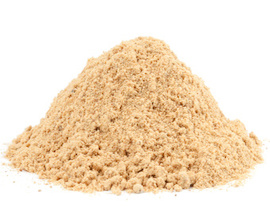 Maca powder.
Maca powder.
Maca (Lepidium meyenii) is a root vegetable that has originated from the South American country of Peru where it had been cultivated for more than 2000 years. (Ref. 1)
Native people consume both Maca's roots and leaves. People in many other countries take it mostly as maca root powder.
Native people prepare Maca in the ways similar to how we cook potatoes. They can boil and mash them, or roast them, or turn them into flour for further use in baking.
In other words, Maca is a pure food. We recommend this fantastic plant as a gentle energiser and general stimulant to help lift occasional or chronic tiredness. (Ref. 2)
It is also specifically recommended for chronic fatigue syndrome. (Ref. 3)
Maca is referred to as a superfood for a good reason: its high nutritional value. It sure offers a broad spectrum of healthy nutrition including vitamins, minerals, amino acids, fatty acids as well as alkaloids and tannins. (Ref. 3)
In fact, maca is highly prized by people on raw-food diets for its protein content. Many of them consume it as a replacement for animal protein.
Maca is a well-known adaptogen. (Ref. 1)
It is an interesting phenomenon which means that an adaptogen's action brings the body back into balance after it has been through physical or emotional stress, and thus limits the potential damage to the system.
So maca may help strengthen a person's stamina and heal the body as a whole.
Learn more about some other adaptogens here:
Maca is taken medicinally to deal with female hormonal issues, ex. menopause. (Ref. 2) It may act as an aphrodisiac and work to re-balance the whole hormonal system. (Ref. 4)
Maca has also become a popular ingredient in a variety of herbal tea blends.
Written by: Irina Bright
Original publication date: 2013
Republication date: 2020
References.
1. Gustavo F. Gonzales (2011). Ethnobiology and Ethnopharmacology of Lepidium meyenii (Maca), a Plant from the Peruvian Highlands. Published in Evidence-Based Complementary and Alternative Medicine. Retrieved June 4, 2013 from: https://www.ncbi.nlm.nih.gov/pmc/articles/PMC3184420/
2. H. O. Meissner, A. Mscisz, H. Reich-Bilinska, P. Mrozikiewicz, T. Bobkiewicz-Kozlowska, B. Kedzia, A. Lowicka, and I. Barchia (2006). Hormone-Balancing Effect of Pre-Gelatinized Organic Maca (Lepidium peruvianum Chacon): (III) Clinical responses of early-postmenopausal women to Maca in double blind, randomized, Placebo-controlled, crossover configuration, outpatient study. Published in International Journal of Biomedical Science. Retrieved June 4, 2013 from: https://www.ncbi.nlm.nih.gov/pmc/articles/PMC3614644/
3. Leslie Taylor (2012). Maca. Herbal Properties and Actions. Published in Rain-tree.com. Retrieved June 4, 2013 from: https://www.rain-tree.com/maca.htm
4. H. O. Meissner, H. Reich-Bilinska, A. Mscisz, and B. Kedzia (2006). Therapeutic Effects of Pre-Gelatinized Maca (Lepidium Peruvianum Chacon) used as a Non-Hormonal Alternative to HRT in Perimenopausal Women - Clinical Pilot Study. Published in International Journal of Biomedical Science. Retrieved June 4, 2013 from: https://www.ncbi.nlm.nih.gov/pmc/articles/PMC3614596/